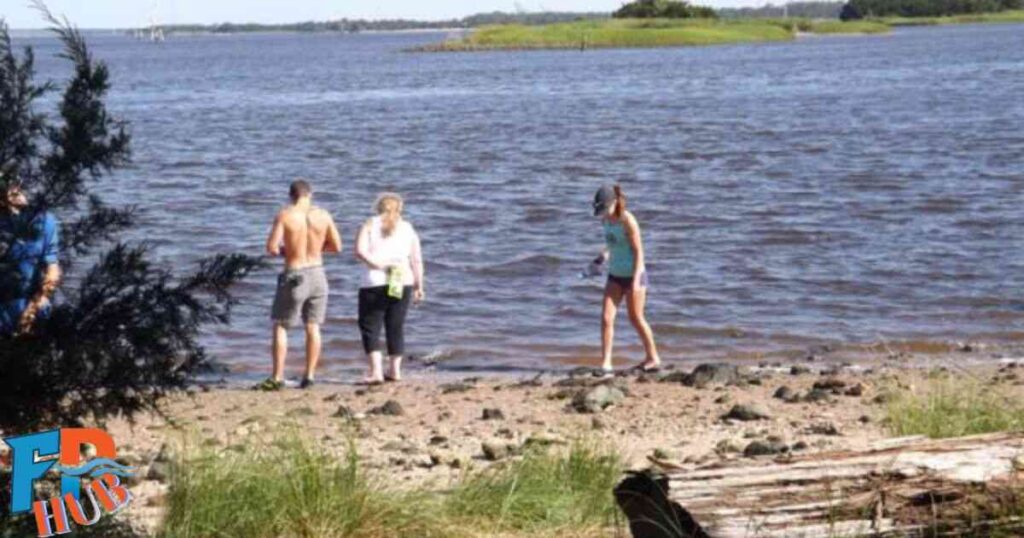Shark Tooth Island NC is a small, unassuming piece of land in the Cape Fear River. It’s easily accessible from Wilmington, making it a popular spot for locals and tourists alike. The island’s name isn’t just for show; it truly is a treasure trove of shark teeth and other fossils.
My first visit to Shark Tooth Island was an eye-opening experience. I was immediately struck by the sheer number of fossils scattered across the shore. It was like walking through a natural history museum, with each step revealing new wonders.
Over the years, I’ve learned that this island is more than just a place to find shark teeth. It’s a window into the prehistoric world that once existed in this region.
The Allure of Shark Tooth Island NC
Location and Accessibility
Shark Tooth Island NC is conveniently located just off the shore of River Road Park in Wilmington. It’s easily reachable by kayak or small boat. The journey to the island is part of the adventure. Paddling across the Cape Fear River, you can already feel the excitement building.
Once you arrive, you’ll find a small, kidney-shaped island. It’s about the size of a baseball diamond. The island’s beaches are where the magic happens. At low tide, expansive stretches of sand and rocky shoreline are revealed. These areas are prime hunting grounds for fossil enthusiasts.
Geological Significance
The geological history of Shark Tooth Island NC is fascinating. The island was formed by dredge spoil in the late 1800s. This occurred when the U.S. Army Corps of Engineers dug channels for large ships. The dredged material contained sediment and limestone rock estimated to be 35-40 million years old.
This ancient material is what makes the island so rich in fossils. The limestone, locally known as “marl,” was once the bottom of a shallow coastal ocean. As a result, it contains a wealth of prehistoric marine life remains. This includes, of course, an abundance of shark teeth.
Historical Context
The history of fossil hunting on Shark Tooth Island NC is as rich as its geological past. Local legend Kolby Bass played a significant role in popularizing the island. His discoveries and efforts to educate the public have inspired many fossil hunters.
Over the years, the island has attracted both amateur enthusiasts and professional paleontologists. Many significant finds have been made here. These discoveries have contributed to our understanding of prehistoric marine life in the region.
Types of Shark Teeth Found on Shark Tooth Island NC

Prehistoric Shark Species
Shark Tooth Island NC offers a diverse array of shark teeth from various prehistoric species. You can find teeth from ancient sharks that swam in these waters millions of years ago. Some of the most common species represented include Megalodon, Mako, and Sand Tiger sharks.
Each type of tooth tells a story about the shark it came from. The size, shape, and serrations can indicate the species and sometimes even the shark’s size. It’s thrilling to hold a tooth in your hand and imagine the massive creature it once belonged to.
Common Shark Tooth Types
During my time exploring Shark Tooth Island NC, I’ve come across many types of shark teeth. The most common are from more recent species like the Bull Shark and Lemon Shark. These teeth are typically smaller and darker in color due to fossilization.
Identifying these common teeth becomes easier with practice. Look for the distinctive triangular shape and sharp edges. Some teeth may have serrations, while others are smooth. The root structure can also provide clues about the species.
Rare and Unique Finds
While common teeth are exciting, it’s the rare finds that truly get a fossil hunter’s heart racing. On Shark Tooth Island NC, you might be lucky enough to find a Megalodon tooth. These massive teeth can be several inches long and are highly prized by collectors.
Other rare finds include teeth from extinct species like Otodus or Hemipristis. These unique specimens offer valuable insights into ancient shark diversity. Each rare tooth found is a small piece of a much larger prehistoric puzzle.
Shark Tooth Hunting Techniques on Shark Tooth Island NC

Surface Collection Methods
Surface collection is one of the most popular methods for finding shark teeth on Shark Tooth Island NC. This technique involves carefully scanning the beach surface for exposed teeth. It’s a simple but effective method that requires patience and a keen eye.
I’ve found that walking slowly along the waterline often yields the best results. The wave action can expose teeth hidden just beneath the surface. Look for the distinctive black or dark brown color of fossilized teeth. Sometimes, you might only see a small part of the tooth sticking out of the sand.
Sifting and Screening Techniques
For those looking to increase their chances of finding smaller teeth, sifting and screening can be highly effective. This method involves using a sieve or screen to sift through sand and sediment. It’s particularly useful in areas where smaller teeth and fragments are abundant.
To sift effectively, scoop up a handful of sand and gently shake it through your sieve. The sand will fall through, leaving behind any teeth or other fossils. This technique requires more equipment but can lead to some exciting finds that might otherwise be overlooked.
Underwater Search Strategies
Searching for shark teeth underwater can be a rewarding experience on Shark Tooth Island NC. This method involves wading into shallow water and looking for teeth on the submerged bottom. It’s best done on calm days when the water is clear.
I’ve found that using a mask and snorkel can be helpful for underwater searches. It allows you to see the bottom more clearly without having to constantly surface for air. Remember to be cautious of currents and never search alone in deep water.
Best Times to Visit Shark Tooth Island NC

Seasonal Considerations
The best time to visit Shark Tooth Island NC for shark tooth hunting can vary depending on the season. In my experience, spring and fall offer the most comfortable temperatures for extended hunting sessions. Summer can be quite hot, while winter might be too chilly for some.
However, each season has its advantages. Summer storms can churn up the sediment, exposing new fossils. Winter often sees fewer visitors, potentially leaving more teeth undiscovered. Regardless of the season, always check the weather forecast before planning your trip.
Tidal Influences
Understanding tides is crucial for successful fossil hunting on Shark Tooth Island NC. Low tide is generally the best time for shark tooth hunting. It exposes more of the beach, giving you a larger area to search. I’ve found the Campbell Island Tide Chart to be the most accurate for planning trips.
Aim to arrive about 1.5 hours before low tide peaks. This gives you plenty of time to search as the tide recedes and continues to expose new areas. Remember, the tide can come in quickly, so always be aware of your surroundings and have a plan to return safely.
Time of Day
The time of day can also impact your fossil hunting success on Shark Tooth Island NC. Early morning and late afternoon often provide the best lighting conditions for spotting teeth. The low angle of the sun can create shadows that make teeth easier to see.
However, don’t discount midday hunting. While the glare can be strong, the overhead sun can sometimes make dark teeth stand out against the lighter sand. Experiment with different times to see what works best for you.
Preparing for Your Shark Tooth Island NC Adventure
Essential Equipment
Proper equipment can make your shark tooth hunting experience on Shark Tooth Island NC more enjoyable and productive. At a minimum, bring a small shovel or trowel, a sieve, and a container for your finds. A hat, sunscreen, and plenty of water are also essential.
Consider bringing a magnifying glass for examining smaller teeth and a field guide for identification. If you plan on doing any underwater searching, a mask and snorkel can be helpful. Always pack out what you pack in to help preserve the island for future fossil hunters.
Safety Precautions
Safety should always be your top priority when visiting Shark Tooth Island NC. The island is only accessible by water, so ensure you have a reliable means of transportation. Check weather and tide conditions before setting out. Always let someone know your plans and expected return time.
Be aware of potential hazards like sharp shells, slippery rocks, and strong currents. Wear appropriate footwear to protect your feet. If kayaking to the island, be mindful of larger vessels in the river and their wakes. Remember, no fossil is worth risking your safety.
Conservation and Ethics
As fossil hunters, we have a responsibility to preserve Shark Tooth Island NC for future generations. Practice responsible collecting by taking only what you need and leaving the site as you found it. Avoid digging deep holes or disturbing vegetation.
Be mindful of wildlife on and around the island. Some areas may be nesting sites for birds or other animals. Always follow any posted rules or guidelines. By being ethical fossil hunters, we ensure that Shark Tooth Island NC remains a treasure trove for years to come.
Identifying Your Finds from Shark Tooth Island NC
Shark Tooth Anatomy
Understanding shark tooth anatomy is crucial for proper identification of your finds from Shark Tooth Island NC. A typical shark tooth consists of a crown (the visible part above the gum line) and a root. The crown can be smooth or serrated, depending on the species.
Look at the shape of the tooth, its size, and any distinctive features like serrations or cusps. The root structure can also provide important clues. Some teeth have a U-shaped root, while others have a more flattened appearance. With practice, you’ll become adept at recognizing different species based on these characteristics.
Common Misidentifications
When shark tooth hunting on Shark Tooth Island NC, it’s easy to mistake other objects for shark teeth. Shell fragments, small rocks, and even bits of driftwood can sometimes resemble teeth at first glance. One common misidentification is mistaking skate or ray teeth for shark teeth.
To avoid these errors, familiarize yourself with the characteristics of genuine shark teeth. They typically have a glossy appearance and a distinctive shape. If in doubt, consult a field guide or ask a more experienced collector for help. Remember, even experts sometimes make mistakes, so don’t get discouraged if you misidentify something.
Resources for Identification
There are numerous resources available to help you identify your finds from Shark Tooth Island NC. Field guides specific to fossil shark teeth are invaluable. I recommend “The Fossil Shark Teeth of North Carolina” by George Powell as an excellent starting point.
Online resources can also be helpful. Websites like fossilguy.com offer extensive galleries and identification tips. Many fossil hunting forums have experts who can help with tricky identifications. Local museums, like the Cape Fear Museum in Wilmington, often have displays of local fossils that can aid in identification.
Beyond Shark Teeth: Other Fossils on Shark Tooth Island NC
Marine Fossils
While shark teeth are the main attraction, Shark Tooth Island NC offers a variety of other marine fossils. During my explorations, I’ve found fossilized shells, coral fragments, and even the occasional vertebra from ancient fish. These fossils provide a more complete picture of the prehistoric ecosystem.
One particularly interesting find are the teeth of ancient ray species. These are often small and can be easily overlooked. Fossilized sand dollars and sea urchins are also sometimes found. Each of these fossils adds to our understanding of the ancient marine environment that existed here millions of years ago.
Read This Blog: Sol Leon Net Worth 2024: Career, Husband, Age, Height, and Bio
Plant Fossils
Although less common, plant fossils can also be found on Shark Tooth Island NC. These typically come in the form of petrified wood or impressions of leaves in sedimentary rock. While not as abundant as marine fossils, plant remains offer valuable insights into the prehistoric terrestrial environment.
Finding plant fossils on the island is a reminder that sea levels have fluctuated dramatically over geological time. Areas that are now underwater were once dry land, supporting diverse plant life. These plant fossils help paleontologists reconstruct ancient landscapes and climates.
Trace Fossils
Trace fossils, or ichnofossils, are another fascinating find on Shark Tooth Island NC. These are not remains of organisms themselves, but rather evidence of their activity. This can include fossilized burrows, tracks, or even coprolites (fossilized feces).
While less glamorous than a large shark tooth, trace fossils provide unique information about ancient animal behavior. They can tell us about how prehistoric creatures moved, what they ate, and how they interacted with their environment. Keep an eye out for unusual patterns or structures in the rocks – they might be trace fossils!
Shark Tooth Island NC Compared to Other Wilmington Beaches
Unique Features of Shark Tooth Island NC
Shark Tooth Island NC stands out among Wilmington beaches for shark teeth for several reasons. Its location in the Cape Fear River, rather than on the ocean coast, creates unique conditions for fossil preservation. The island’s formation from dredged material concentrates fossils in a relatively small area.
Unlike many coastal beaches, Shark Tooth Island is less affected by tourist traffic. This means that new fossils are constantly being exposed by natural processes, rather than being quickly picked up by beachgoers. The island’s limited accessibility also helps preserve its fossil resources.
Other Notable Fossil Hunting Spots
While Shark Tooth Island NC is exceptional, other Wilmington beaches also offer opportunities for fossil hunting. Carolina Beach and Kure Beach are popular spots for finding shark teeth and other fossils. These beaches are more easily accessible but can be crowded during peak seasons.
Topsail Island, about 40 miles northeast of Wilmington, is another excellent location for shark tooth hunting. Its long stretches of beach provide ample opportunities for fossil discovery. Each location has its own unique characteristics and fossil assemblages, making it worth exploring multiple sites.
When to Choose Shark Tooth Island NC
Shark Tooth Island NC is the best choice when you’re looking for a more adventurous fossil hunting experience. If you enjoy kayaking or boating and want to explore a less-traveled area, this island is perfect. It’s also ideal for those seeking a higher concentration of fossils in a smaller area.
Also Read This Blog: Can Birds Eat Cat Food? Full Guide
However, if you prefer easier access or are new to fossil hunting, you might start with more accessible beaches like Carolina or Kure. Shark Tooth Island requires more planning and preparation but often rewards visitors with unique finds and a memorable experience.
Preserving and Displaying Your Shark Tooth Island NC Finds
Cleaning and Preserving Shark Teeth
Proper cleaning and preservation of your finds from Shark Tooth Island NC is crucial. For most shark teeth, gentle cleaning with water and a soft brush is sufficient. Avoid using harsh chemicals or abrasive cleaning methods, as these can damage the fossils.
For long-term preservation, store your teeth in a cool, dry place away from direct sunlight. Some collectors choose to apply a thin layer of mineral oil to prevent cracking, but this is generally unnecessary for most shark teeth. Always handle your fossils gently to avoid damage.
Creative Display Ideas
There are many creative ways to display your shark tooth collection from Shark Tooth Island NC. Shadow boxes are popular, allowing you to arrange teeth by species or size. Some collectors create artistic arrangements, using teeth to form shapes or patterns.
For a more educational display, consider creating a timeline showing the evolution of shark species. You could also create a map of Shark Tooth Island NC, marking where you found each specimen. The possibilities are limited only by your imagination!
Documenting Your Collection
Keeping detailed records of your finds from Shark Tooth Island NC is important for both personal and scientific reasons. Note the date, location, and tidal conditions for each fossil you collect. Photographs can be helpful for documenting your finds and tracking changes in the island over time.
Consider creating a digital catalog of your collection. This can include photos, measurements, and identification details for each specimen. Not only does this help you organize your collection, but it can also be valuable for researchers studying the fossil record of the area.
The Science Behind Shark Tooth Island NC
Paleontological Significance
Shark Tooth Island NC is more than just a fossil hunting destination; it’s a site of significant paleontological interest. The fossils found here provide valuable data about prehistoric marine ecosystems. They offer insights into the diversity of shark species that once inhabited these waters.
Research conducted on fossils from the island has contributed to our understanding of shark evolution. The abundance and variety of shark teeth allow scientists to study changes in shark populations over time. This information is crucial for understanding both past and present marine ecosystems.
Environmental Changes Over Time
The fossils found on Shark Tooth Island NC tell a story of dramatic environmental changes. The presence of both marine and terrestrial fossils indicates fluctuations in sea level over millions of years. These changes have profoundly impacted the flora and fauna of the region.
Studying the fossil record from the island helps scientists reconstruct past climates and environments. This information is invaluable for understanding
Frequently Asked Question
Who owns Shark Tooth Island?
Shark Tooth Island NC is public land managed by the state of North Carolina. It’s part of the Cape Fear River system and is accessible to the public for recreational activities like fossil hunting.
How to visit Shark Tooth Island?
To visit Shark Tooth Island NC, you’ll need to access it by water. Most people kayak or take a small boat from River Road Park in Wilmington. It’s about a short paddle across the Cape Fear River. Always check tide schedules and weather conditions before your trip.
Can you camp on Shark Tooth Island NC?
Camping is not officially permitted on Shark Tooth Island NC. The island is primarily used for day trips and fossil hunting. Visitors are expected to leave before nightfall. Always follow local regulations and practice Leave No Trace principles.
What is shark island NC?
Shark Island NC, often referred to as Shark Tooth Island, is a small island in the Cape Fear River near Wilmington, North Carolina. It’s famous for its abundance of fossilized shark teeth and other marine fossils, making it a popular destination for fossil hunters and nature enthusiasts.
Conclusion:
Shark Tooth Island NC truly is a fossil hunter’s paradise, offering a unique blend of natural beauty and prehistoric treasures. Its rich geological history, combined with the thrill of discovery, makes it an unforgettable destination for both amateur enthusiasts and seasoned collectors.
The island not only provides an opportunity to find fascinating fossils but also serves as a window into the ancient world that once existed in this region. As we explore and learn from Shark Tooth Island, we gain a deeper appreciation for the Earth’s history and the incredible creatures that once roamed these waters.
The importance of conservation cannot be overstated when it comes to preserving this remarkable site. By practicing responsible fossil hunting and respecting the island’s delicate ecosystem, we can ensure that future generations will have the chance to experience the wonder of Shark Tooth Island NC.
Whether you’re drawn by the allure of finding a megalodon tooth or simply wish to connect with nature in a unique way, Shark Tooth Island offers an adventure like no other. It stands as a testament to the enduring fascination we have with the prehistoric world and the secrets it still holds.











